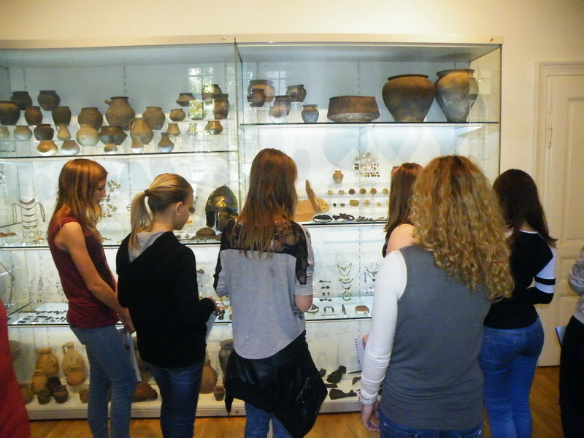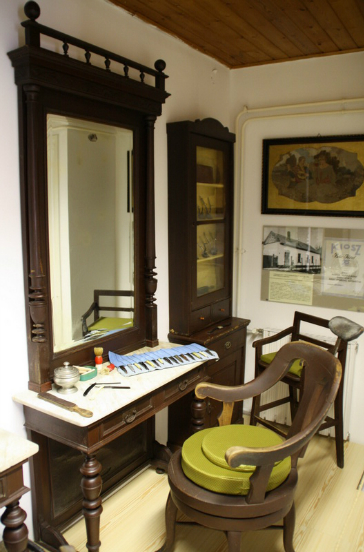Museums in the country-side 2016: József Koszta Museum, Szentes
DR. MÁRIA BÉRES
Our new interview series asks museum directors about their institutions. For the second interview we travelled to a small town in the south-east of Hungary to meet Dr. Mária Beres.
| Basics Beatrix |
2016-01-24 13:32 |
 What changes has the elimination of the county-based museum system brought along?
What changes has the elimination of the county-based museum system brought along?
It has created a lot of problems and it has also put extra burdens on our colleagues. To be able to understand this, we need to go back in time a bit. Szentes, due to the municipality reform between 1950 and 1962, became a marginal town losing its potential for dynamic development. At the end of the socialist period jobs started to disappear, many white-collar workers left the town for good. This trend started to accelerate around 2000 when even skilled-workers began to move out of the town. This trend came along with a drop in the living-standard, so when we started to think about the future of the museum here, we needed to find out a new strategy first.
The museum is in a difficult situation because, while its foundation was the result of a local middle-class effort, financial as well as intellectual, formally it has always been funded by the county municipality. The town has always supported the museum, but in the past it never actually had to run it. However, this changed in 2013. Moreover our collection is rich and huge, in fact it is somewhere in the 8-13 place in this respect concerning the museums in the country-side. Besides the main building we have three other premises where visitors can go and see exhibitions.
Clearly, the town council was wary about the museum, so in 2013, when the town overtook us from the county, we were merged with the town’s cultural centre. Later we became independent, but the financial field is still controlled and done by the Cultural centre, although it has its advantages too: we can concentrate on professional issues more efficiently. Nevertheless, an act passed by the parliament in 2014 will force us to restructure again.

The county museum structures were not the same in every county. Here the financial field was strongly centralised, but in terms of professional work we had a lot of freedom. Due to this, when the county structure was sliced up and museums went to the local municipalities, we had a lot of professional experience and a useful network of museologists. Writing applications was not a problem, running project was nothing new either, and we also successfully took over the tasks related to archeological excavations. Having said that, we did have human resources and budget problems.
How is the museum financed and what other support do you get from the municipality?
Half of our budget is state subsidy and the other half comes from the local government. In addition the museum generates income and we apply to funds to finance our projects. The proportion of the state contribution seems to be a bit low, but it tends to be increasing recently, and we hope that this trend will continue. In terms of project work it is mostly our own revenue and the different funding programs we apply to which are the prime resources. Still, the 50% support from the council reflects the responsibility the town takes for the museum. In return for this, of course, they have expectations, too. Besides all this, we feel appreciated here, and it is really good.
 Since 1990 the population of the town decreased by 5000, which is significant when we talk about a settlement with about 30.000 inhabitants. The local government has been making efforts to reverse this trend and to create a liveable town where tourism, especially health and sport tourism, is a major source of economic growth. We have based our strategy on this, which means that besides strengthening local identity, we are targeting tourists and are trying to offer them something interesting continuously.
Since 1990 the population of the town decreased by 5000, which is significant when we talk about a settlement with about 30.000 inhabitants. The local government has been making efforts to reverse this trend and to create a liveable town where tourism, especially health and sport tourism, is a major source of economic growth. We have based our strategy on this, which means that besides strengthening local identity, we are targeting tourists and are trying to offer them something interesting continuously.
Szentes is large rural town with strong traditions rooted in this rural culture. Many of the families are still carrying their farming as well as town-dwelling traditions at the same time. At an institutional level, the local archive and the museum are the most important guardians of these traditions. A large amount of documents of the archive were destroyed during the past one hundred years, so the museum has become very important in shaping the collective memory. Moreover, there is no higher education in the town, so the museum has been playing an important role in local scientific life as well as in educating the public. We would like to be an institution which has a collection, and which supports school and adult education. Our long term development strategy is based on this and we have successfully integrated this strategy into the town’s cultural strategy.
How far have you got in those fields which are seemingly the background work in a museum namely cataloguing, conservation or digitalisation?
Unfortunately cataloguing is behind schedule and this is something we would like to speed up, but for this we need additional human resources. This process is very challenging for any museum, but it is the basis of any serious scientific work. Of course, it also depends on the funding of the museum but with a lot of work and with involving volunteers we can reach our goals.
What exhibitions are you planning and what about your permanent exhibition?
This museum here in Szentes is too small to cerate blockbuster exhibitions. They are extremely costly and the potential audience which could pay a higher price for the tickets is limited here. So we do not want to go down that way. We create smaller exhibitions related to diverse topics which are important from a professional or scientific point of view. We were able to acquire some facilities which are vital for a modern museum and now we have to find out how to use these in the most efficient way.
How many people come to the museum and how would you characterise your connection to the local community?
We have created a new interior exhibition depicting a barber shop and are presently working on an exhibition which will place the middle-class kitchen in its focus. Every year we have 4-8 temporary exhibitions, on average we have one scientific or popular event a week, and annually approximately 6-8000 people take part in our museum pedagogy sessions. The number of visitors per year reaches 15.000, but due to a special European Union support in 2014, this number exceeded 24.000 that year. If you take into account that the entire population of this town is 27.000, that’s not bad at all. We also know that 2/3 of the local families with children are repeat visitors. That is the 30% of the inhabitants, which is again a significant figure.
We have already talked about the museum’s headcount. How much do you and your colleagues feel appreciated?
When the museum became a town institution we had 9 full-time positions, and this has expanded a little bit, not as much as it should have been, but for every field we have at least one person in a 4-hour per day position. However, we can only maintain last years’ momentum if we can increase the number of positions here. Someone falls ill or goes on holiday and we are immediately stretched to the limit. Half-time positions are quite understandably not very attractive for the young or the older generations either.
We would like to work in a calm and predictable environment, knowing that if we reach our strategic goals we and our work will be appreciated.